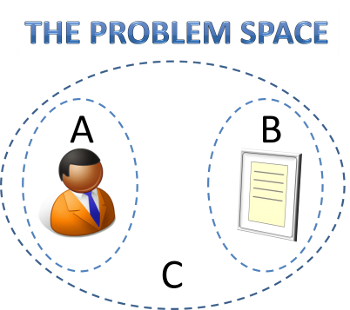Table of Contents
The Space of A, B and C
Introduction
Writing and placing a mission statement sets up a situation where there is an observer (the client at A below), the observed (the mission statement at B) and the space in between them both (C).
Figure 7
The Three Spaces
The Space of A
When the observer chooses the place they want to sit or stand in respect to their mission statement, this place and the space around them becomes the ‘Space of A’, this space holds who they are and what they know at the beginning of the session.
Throughout the session, the client needs to be returned to this position occasionally, because this is the position that defines the edge of their Primary World.
They will also need to go back to this position to end the session. As when they are in a different positions/spaces during the process they may be in the state of mind where they are at different ages. Returning to the space of A will ensure they are in their right mental state, as a whole person.
The Spaces of B and C
The mission statement and the space around it is the ‘Space of B’ and the boundary of the space in between is the ‘Space of C’, the figure below shows this.
Figure 8
Asking Questions of the Spaces
The facilitator can ask questions of the person (A), the mission statement (B) and even of the space in between (C), in the belief that space can hold information as well as the person or mission statement.
The questions are not limited to only what the observer knows; information is valuable no matter where it comes from. If questions are only ever asked of the observer, there will be very interesting and useful information missed.
When the person is in the space of A, anything that they say about the nature of their problem could be irrelevant to the solution. Their information is not very useful in terms of solving the issues because they continue to have the same perspective on their problems as they did when they arrived. As long as the person stays in one position, their problem will always be configured in the same way.
Spaces and Client Perspectives
In the space of A, a person may hold a particular view of the world; that is only true as long as they sit there. But if they were asked to move to another space they are then equally capable of discounting everything they said in the previous position.
The concept of moving to another space is known as adjacency because we are moving the client to adjacent spaces within their problem space. This problem space can actually be represented by expanding the ‘Space of C’ so that it contains both A and B. In reality this is the true basic structure of the problem, i.e. the problem space, its boundaries and limits are what is keeping A and B in this feud, it is what is stopping A and/or B from being resolved.
Figure 9


